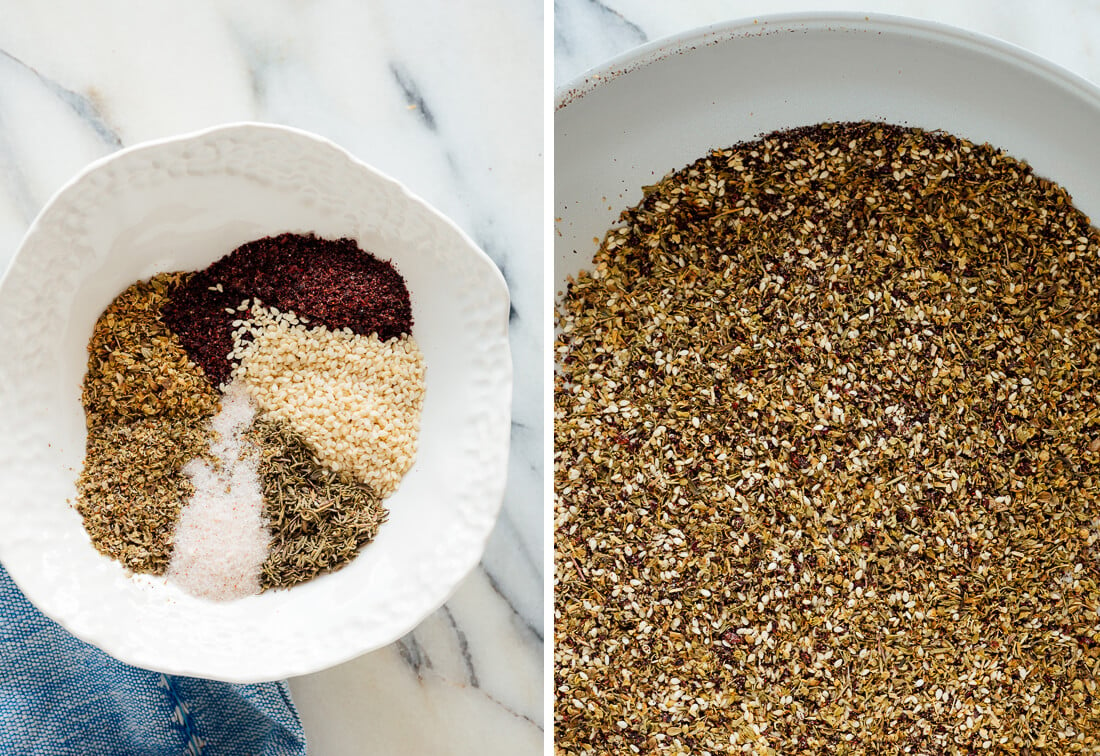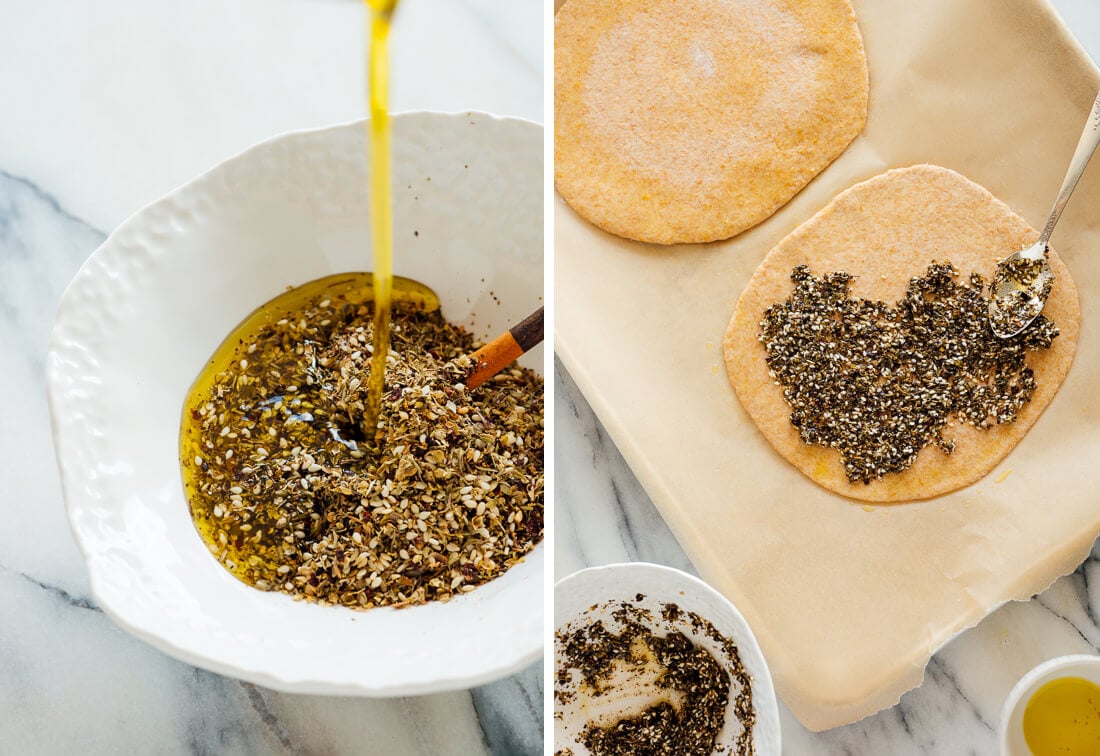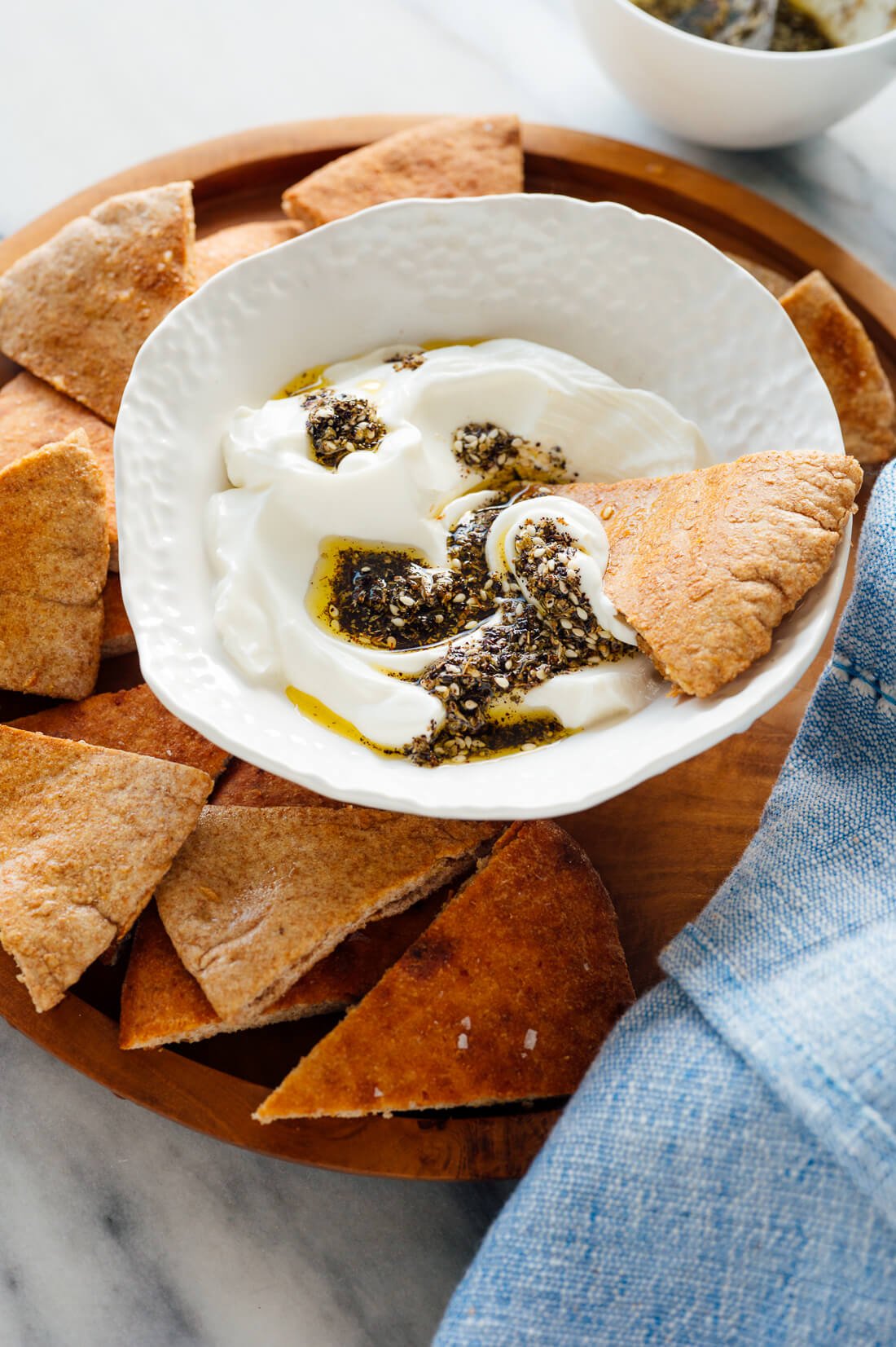Za’atar Spice Blend
Learn how to make za'atar, the classic Middle Eastern seasoning, with this easy recipe. You'll need dried oregano, sumac, sesame seeds, marjoram and thyme.
Updated by Kathryne Taylor on August 30, 2024
53Comments
Jump to recipeI’m having a moment with za’atar, a classic Middle Eastern seasoning. Za’atar is a unique blend of herbal, earthy, savory, tangy and salty flavors.
Za’atar has been enjoyed for centuries on the other side of the world, yet it has gained popularity in the U.S. over the past five years or so. To be honest, I didn’t understand the fuss when I sampled a za’atar blend from Trader Joe’s several years ago. But then…
Everything changed when za’atar landed on our table at Shaya in New Orleans. They simply mixed their house blend of za’atar with olive oil and served it with crusty bread, for dipping. I fell in love with za’atar that night, and couldn’t stop going back for more.
This recipe is my best attempt at recreating the flavors in Shaya’s recipe, and I think it’s pretty close. Za’atar is versatile and complements many savory meals—you’ll find all of my suggestions below.
Watch How to Make Za’atar Spice Blend
Za’atar Ingredients
Za’atar recipes vary significantly from place to place and home to home (some are well-guarded family secrets). Za’atar’s origins are fascinating, and also confusing and contradictory. You can read about it all here.
Za’atar is known as “brain food” for its antioxidant and medicinal properties. This za’atar recipe is made with several ingredients that you probably have in your kitchen already! The one exception is sumac, but hear me out, it’s worth buying.
Here’s what you’ll need:
Dried Oregano
Preferably a Greek or Turkish variety, rather than Mexican.
Sumac
Sumac is one of my favorite spices. It’s bright, pinkish red, and has an irresistible tart, almost lemony flavor. You can sprinkle sumac on hummus, and it’s also irresistible on watermelon and cucumber with some flaky salt (the combination reminds me of Tajín seasoning). I buy sumac on Amazon (affiliate link).
Sesame Seeds
You won’t find sesame seeds in every za’atar recipe, but I don’t want za’atar without them! They become extra savory and delicious once toasted.
Marjoram
If you don’t have marjoram, you can replace it with more oregano (they’re cousins).
Thyme
Thyme rounds out the herbal flavors of oregano and marjoram.
Uses for Za’atar
- Mix za’atar with olive oil and spread it over pita bread (or pita dough) before baking. This is called man’oushe. I don’t have my own pita dough recipe yet, but I used my go-to pizza dough divided to make four rounds, and it worked well.
- Serve bowls of za’atar mixed with olive oil and crusty bread, for dipping. Or more simply and perhaps more common, serve bread alongside a dipping bowl of olive oil and a separate bowl of dry za’atar.
- Mix it with olive oil and drizzle it over labneh, thick yogurt (plain Greek or Siggi’s), hummus or baba ganoush. Serve it with pita wedges or raw veggies.
- Roll extra-thick rounds of labneh or a log of goat cheese in the dry spice mixture. Serve it as an appetizer with pita wedges, crackers or crisp, raw vegetables.
- Use the olive oil mixture as a marinade, or the plain spice blend as a dry rub. Za’atar would be great on grilled vegetables and kebabs.
- Incorporate za’atar in a salad, like Bon Appetit does with their tomato and pita crisp salad. See below for accompaniments.
Za’atar Goes Well With…
- Cauliflower
- Cucumber
- Dairy: Feta, goat cheese, labneh and yogurt
- Eggplant
- Fennel
- Fresh leafy herbs (parsley, mint and cilantro)
- Lemon or lime
- Pistachios
- Pita bread
- Potatoes
- Olive oil and olives
- Quinoa and rice
- Tomato
Love za’atar? Here are a few more of my favorite Middle Eastern recipes:
- Baba Ganoush: Smoky and irresistible eggplant and tahini dip.
- Dukkah: Egyptian nut and spice blend.
- Fattoush Salad with Mint Dressing: Fresh green salad with pita bread as “croutons.”
- Hummus: Seriously the most creamy hummus you’ll ever have.
- Mujaddara: Lentils and rice with caramelized onions on top.
- Shatta: Thick green hot sauce made with jalapeño, parsley, cilantro and walnuts.
- Tabbouleh: Bulgur salad with loads of fresh parsley.
- Tzatziki: Creamy, tangy, herbed cucumber and yogurt sauce.
Please let me know how your za’atar recipe turns out in the comments! I can’t wait to hear from you.
Za’atar Spice Blend
Learn how to make za’atar, the classic Middle Eastern seasoning, with this simple recipe. You’ll need dried oregano, sumac, sesame seeds, marjoram (optional) and thyme. Recipe yields ½ cup and keeps for up to 1 month.
Ingredients
- 2 tablespoons dried oregano, preferably Greek or Turkish
- 2 tablespoons sumac
- 2 tablespoons sesame seeds
- 1 tablespoon dried marjoram or additional oregano
- 1 tablespoon dried thyme
- 1 teaspoon fine sea salt
Instructions
- Simply combine all of the ingredients in a bowl or jar, and stir to combine.
- For enhanced flavor, warm the spices together in a medium skillet over medium heat, until fragrant and the sesame seeds are starting to turn golden. Remove from the heat and transfer to a bowl to cool. (Skip this step if you will be baking your za’atar on pita bread, which essentially does the same thing.)
- Store za’atar in an air-tight container at room temperature for up to 1 month.
Notes
Recipe roughly adapted from Zaitoun by Yasmin Khan.
Serving suggestions: Mix za’atar with olive oil and spread it over pita bread (or pita dough) before baking. Or dip bread into olive oil, followed by a dunk into the za’atar blend. Mix za’atar with olive oil and drizzle it over labneh, Greek yogurt or hummus. Roll extra-thick rounds of labneh or a log of goat cheese in the dry spice mixture. Use the olive oil mixture as a marinade, or the plain spice blend as a dry rub.
Olive oil ratio: Two parts za’atar to one part olive oil will yield a thick, spreadable consistency. Equal parts yields a drizzly sauce.
Nutrition
The information shown is an estimate provided by an online nutrition calculator. It should not be considered a substitute for a professional nutritionist’s advice. See our full nutrition disclosure here.























Great recipe and I am glad you added in the sesame seeds! I also appreciate all the suggestions of how to serve and which veggies it pairs well with. I buy it in little round tins from The Spice Road but I have no doubt homemade is mo bettah! Thank you!
You’re welcome! Thanks for your review.
Hi
Your recipes are usually very accurate but you are missing the main ingredient in the Za’atar mix which is the Zaatar plant itself. It is similar to oregano but has its own unique taste. In Israel we put it on everything. Shaya must be keeping this secret to himself.
Hi Dennie! Thanks for your feedback. I try to keep recipes as authentic as I can, while making it my own/ingredients available to people. I bet that’s delicious!
to Dennie…
there is no spice named “zaater” the thyme’s name in arabic is zaater… and because thyme is the main ingredient in zaater so is the mixture called zaater….
I have known the za’atar for a long time. Lately they have given me a 500g package of za’atar bought in Lebanon. Search on IG #cucina_caselle and find some dishes I have prepared!
Giovanni (gioxy.gio)
Thank you for sharing, Giovanni!
I love making this mid eastern spice. I have a wonderful Syrian grocery store near me w/such a great variety of spices that I can only find at this store. I have several friends living in Israel & they share w/me their recipes & I have made all of them. Absolutely delish!!!!
Let me know what you think when you try it, Terri-Andy!
I just has za’atar on pita, lightly baked until pita was crunchy. It was made from scratch by my friend’s husband who has been eating his entire life. I thought I died and went to heaven…and then your recipe popped in…can’t wait to try it!
Be sure to let me know how it compares, Marie!
I love this spice mixture, although I usually get mine when I am visiting friends in Berkeley. When I run out I will for sure take you up on your recipe! I am going to be in Ashland Oregon next week and there is a spice house where I may be able to pick up some actual ground Za’atar that was mentioned by another commenter. Thanks!
You’re welcome! I love how excited you are about this recipe, Sharon.
I first tried Za’atar when I was on holiday in Israel. We had a delicious soup and I asked what the wonderful spice blend was in the soup and they said Za’atar. The waitress also told me she uses it is stews, roasted veggies, etc. I bought a bottle and brought it home. I am so excited to try your recipe because my bottle of Za’atar that I brought back from Israel is almost gone. I’ve had several times people have complimented on my soup or stew and the flavours they like I’m sure are from my Za’atar spice.
Penzeys spice co.co sells it. I put it in my humus when I made it.
Thanks for sharing how you have heard it used! Let me know what you think when you try it, Linda.
The plant is called biblical hyssop and is different from the Greek oregano that we know. The part that should be used is the flower when it is mature. That’s the best Zaatar. I used to pick them up for my mother from the woods of Lebanon. The leaves makes the cheap Zaatar you buy in the stores!!!
The knowledge gives by you is not only helpful for me but also for all humans. thank you very much.
I hope you like the recipe, Jennifer!
Hi Girl! Diane Kochilas’ pita recipe in The Food and Wine of Greece is authentic. I’ve made both whole wheat and white many times. The batch I made for a party last weekend was a sensation. I scaled the dough into 24 portions, grilled them over charcoal and they puffed up, browned and were just perfect. I made bread flour by adding 1teaspoon of wheat gluten to1cup of AP flour. Excellent, authentic pita is easy! All the best to you dear.
Thank you for sharing, Deedee!
Ohhh now I am gonna have to try that new recipe as well! Thank you!
You’re welcome, Marissa!
I got introduced to Za’atar not that long time ago by a new friend with roots from the Middle East. Now I’m HOOKED!
I agree, it’s so good!
Thank you so much for the lovely recipe!
This worked well for the sheet pan Chicken and roasted grapes dinner I made Last night. I only had black sesame seeds on hand but otherwise followed exactly. Thank you for posting your version of this spice blend- I wouldn’t have known where to start!
You’re welcome! Thank you for your review, May.
Easy to make. Very flavorful. I am going to make this as token gifts for friends…Fresh dried herbs are important here. While I was able to find Sumac at our local Co Op, I also purchased the brand that was recommended by Kate.
Thank you for sharing, Jennifer! I appreciate your review.
I just made this. It’s the third recipe I have tried and I think it’s the best so far.i reversed the oregano and thyme amounts. When I looked up the plant zaatar the translation was thyme. So I’m sure it’s a different thyme plant but it’s as close as I can get. I’m addicted to this stuff and thank you immeasurably for your recipe
Thanks for sharing, Samantha!
I recently discovered za’atar and it is a revelation! And as you point out Kate can can be used very quickly and simply to make wonderful things. I looked in many stores but was only able to buy it in a common brand (don’t know if I can say the name here). The way I like to use it is to cut paneer in half inch thick slices, coat with za’atar and some coarse salt, and sauté it on both sides in a nonstick pan with some cooking spray. Developed a lovely crust. I wanted to make za’atar from scratch Because it doesn’t seem to be in production right now, at least that’s what an employee at Trader Joe’s told me. I bought sumac from Amazon Because couldn’t find out in the stores either.I don’t think it tasted like it’s supposed to. Just had an absolutely foul, bitter taste so I threw it away.
I thought I had enough of this spice blend for a recipe I was making and went into a panic when I realized I did not have enough. Thankfully I found these instructions which produced a wonderful spice blend that worked perfectly. Thank you.
I’m glad you found the recipe! Thank you for sharing, Sheila.
Found your website on a google search for season blend with za’atar will try your recipe. The sumac I have is years old dont know what the shelf life is. Can you say?
Hi June, I’m not sure. It should be on the packaging somewhere.
I was given a free jar of Za’atar from Penzy’s several years ago. I had no idea how to use it and one night was making a cucumber salad and decided to experiment with it. It’s wonderful and a family favorite now. I slice cucumbers, onion, chopped tomato and diced avacado. For dressing I use Maruchan’s Seasoned Rice Wine Vinegar and Za’atar to taste. I have a bowl of it next to me as we speak. I love it!
I wanted to try this despite the fact that I didn’t have all the ingredients. I had to use basil instead of oregano, so I was only able to use basil, sesame seeds, thyme, and salt, and it was still so tasty. I had made some tzatziki and pita the day before, so I mixed some into the sauce along with olive oil, and it was a delicious dip for my pita bread–I think the tanginess of the tzatziki offset the lack of sumac, and it was a very tasty combination. Thanks for the inspiration!
Thank you for sharing how you were able to make it, Cynthia. I’m glad you were able to enjoy it!
Hi there, I love this recipe! It is a very popular little hostess gift when visiting friends.
Can you tell me why it only can be stored for a month? Wondering if I could make larger batches and freeze it? Any advice would be appreciated.
Bonnie – Ottawa, Canada
You can buy Za’atar in Ottawa at Basics on Merivale Rd.
So glad to find your recipe! I have a recipe I want to try with za’atar as the main flavoring. Couldn’t find it in any store.
Thanks Kate
when I’m looking for recipes and see you have a version I’ll just go to yours as you always come up trumps!
Gemma, Bristol, UK
I am really excited to try this one. Sounds interesting. Question: can you bake with it? Like, say, a roasted or braised chicken dish? I know nothing about Sumac— Will the heat change the flavor? Or is this ok? Thanks!
I’m a vegetarian so I’m not sure about using it on meat. Sorry!
Ohhh boy! I have never heard of zatar nor have I heard of sumac being a seasoning and now I am up for the challenge because I love a good seasoning blend and can’t wait to try both! Also came across a comment about pita and to make it from scratch, I’ve got my work cut out for me and I’m incredibly thankful, I love trying new recipes! I just love cooking in general! Thank you!
You’re welcome, Marissa!
Thanks for the Za’atar spice. Put some together, and just waiting to use it!
Say, what do you know about Borage? How does one use it?
My friend came from Persia in the 80’s (he hates Iran) and gave me some. I looked on the web, but that was non-productive.
Excellent, thank you.
You’re welcome, Lee!
This blend is beautiful! But your process/technique can be improved. Sesame seeds take much longer to bloom over heat. I would suggest toasting the sesame seeds medium/medium low heat alone first. Then use a mortar/pestle or just the back of a spoon in bowl to break the sesame seeds, grind just until broken open, just a bit but not completely to a paste. Then gently bloom your Herbs, Sumac, Salt over low heat. Incorporate into the sesame seeds and grind with mortar and pestle or back of spoon until broken and oils are released. The herbs and especially the Sumac and Salt will burn before you have released the oils in the sesame seeds or other Herbs. I love your combination of ingredients for this recipe. I am using your recipe for Za’atar recipe for a Lebanese artichoke/yogurt dip and it just yummy! I utilize many of your recipes…..Thank You!
You’re welcome, Leanne! I appreciate your review.